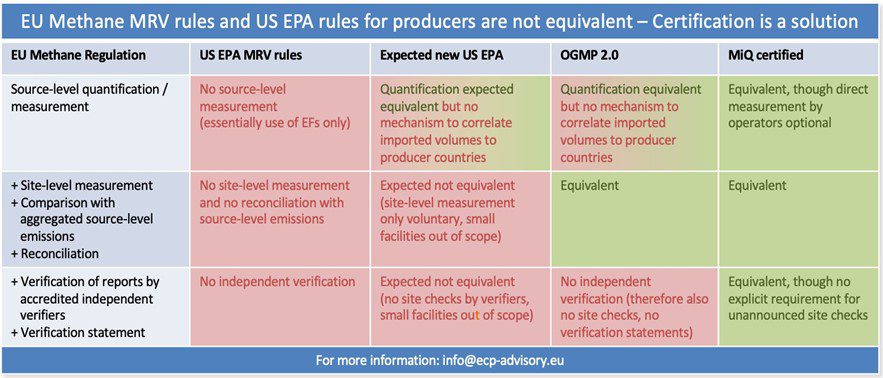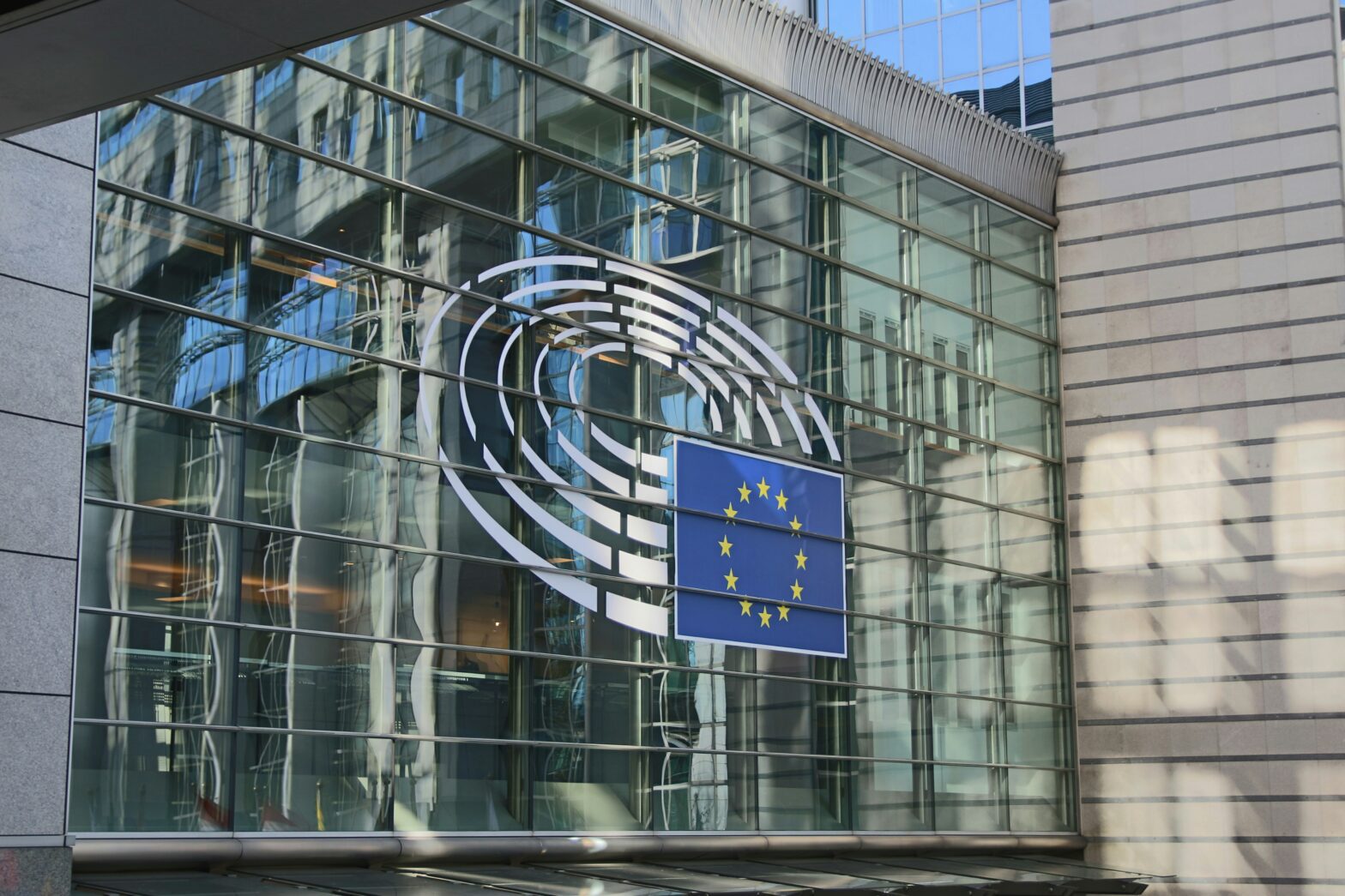12 February 2025
Dear Director-General Ms. Juul-Jøergensen,
Ensuring compliance with the EU Methane Regulation (EUMR) requires a reliable method to verify methane emissions at the production level. However, the complexity of global energy markets results in natural gas and crude oil often changing hands multiple times before reaching the EU. Without a clear framework for determining provenance and verifying emissions performance, importers encounter difficulties in meeting EUMR requirements.
Certification presents a practical solution. MiQ certification is currently operational and offers a transparent, low-cost, and verifiable means for natural gas or crude importers to comply with the EUMR. MiQ certification assigns an emissions measurement, reporting, and verification (MRV) profile to digital certificates at production, much like Guarantee of Origin schemes for renewable electricity. The certification framework sets robust rules to enable continued gas trading between import and export regions, addressing methane compliance and security of supply concerns.
MiQ’s certification framework is currently operational, has a proven track record, and already certifies 240 bcm of production annually.
MiQ Certification: A Ready-to-Use Solution for EUMR Compliance
MiQ is an independent, not-for-profit foundation established in 2019 to tackle methane emissions by certifying performance at the producer level. Our system is already operational and certifies over 240 billion cubic meters (bcm) of natural gas annually, a volume that exceeds EU LNG imports from the United States. The MiQ certification framework:
- Meets or surpasses the EU Methane Regulation’s MRV requirements.
- Ensures independence from industry with open-source standards and governance board
- Measures methane emissions at the asset/facility level, assigns methane intensity (MI) and a methane performance grade to the certified gas or oil
- Relies on accredited, independent expert third-party verifiers/auditors.
- Manages issuance, attributes and transactions in a digital registry
Addressing Key Implementation Challenges
The EUMR involves intricate requirements on importers of natural gas or crude oil from third countries entering the Union market. Importers must provide information regarding: 1) MRV activities at the production level of the imported gas or oil (Article 27); 2) evidence of equivalence in MRV frameworks at the production level (Article 28); 3) and reports on production-related methane emission intensities (Article 29).
MiQ’s certification framework meets each of these requirements (See Appendix III).
We understand that some EU importers, suppliers, global producers, and governments are questioning the feasibility of the EU requirements and highlighting the potential impacts on the security of Europe’s energy supply. MiQ offers a straightforward, verifiable solution to these concerns.
| Challenge | Stakeholder Concern | MiQ Certification Solution |
| Traceability | Gas and oil are commingled during transport, making it impossible or onerous to track emissions back to specific molecules. | MiQ assigns the emissions profile at the production level to certificates on a digital registry, similar to renewable energy certificates or biogas. MiQ regional mass balancing, including for the LNG. pipeline or crude chain, ensures import accountability and tracking. |
| MRV Equivalency | Many producer countries, including the US, do not have national-level MRV frameworks equivalent to EUMR requirements. | MiQ certification provides a global, independently verified MRV and methane performance data, ensuring that producer- level compliance can be demonstrated. This facilitates global adoption of methane targets including by non-EU importers. |
| Penalty Risk for Importers | Uncertainty over reporting requirements increases compliance risk and could lead to supply disruptions or higher costs. | MiQ certification gives importers a clear, verifiable method to report compliance, reducing regulatory risk. |
Why Certification with Regional Mass Balancing is Essential for Markets Functioning
While some have suggested transaction-based tracing mechanisms, these could prove highly complex, increase costs, and diminish liquidity. Natural gas and oil are typically traded multiple times (including through exchanges—therefore without an identifiable counterparty). Purchases and sales for a given market participant are reconciled through daily balancing accounts without the ability to effectively allocate specific sales to specific purchases.
Most transactions are bound by confidentiality agreements in jurisdictions outside of the EU.
Consequently, transaction-based tracing mechanisms are unlikely as practical solutions and would certainly incur significant additional costs
Alternatively, MiQ’s certification framework provides a regionally applied mass-balanced solution between exporting and importing regions, which
- Incentivizes producers to improve methane performance at the producer asset level of the exporting region.
- Allow importers to demonstrate compliance without requiring changes to existing market frameworks or supply availability
- Ensures checks and balances between exporting and importing regions with readily available shipping documentation, managed in a digital registry.
The MiQ framework establishes clear regional and asset incentives for producers to adhere to EUMR-compliant MRV standards and report verified methane intensities. It is not a global book-and- claim program whereby certificates could be wholly separated from the gas they represent on a global basis – thereby losing methane abatement incentives.
The MiQ certification framework is built upon precedents such as schemes recognized by the European Commission under the Renewable Energy Directive. It is enhanced and adapted for global LNG and crude markets and the methane emissions challenge by a.o. regional mass balancing and other requirements. (See Appendix I & II)
National Equivalency Determination
We also take note of letters sent by the U.S. Department of Energy (DoE) and the U.S. Environmental Protection Agency (EPA) to the European Commission last year. These argue that the U.S. domestic regulatory MRV regime to reduce greenhouse gas emissions from the oil and gas sector is ‘consistent with the goals’ of the EUMR. We question this statement as the US regulatory framework does not, for example, require site-level measurements or independent verification, as required by the EUMR. Furthermore, significant numbers of facilities are exempt from the US requirements (see Appendix III)
Next Steps & Request for Engagement
We propose that the European Commission allow industry to develop criteria and industry practices for voluntary certification schemes, which would – if adhered to –enable European importers to demonstrate to their competent authorities’ compliance with EUMR importer requirements.
This would provide regulatory clarity, ensure a level playing field for importers, and establish a strong incentive for producers to improve their methane emissions performance.
In the case revisions to the EUMR are being contemplated, recognize that voluntary certification schemes can provide information about producer-level methane emissions performance as required by the EUMR importer requirements, thereby setting the intended incentive for methane emission reductions at the producer level.
We would welcome the opportunity to present our approach in detail and discuss how certification can support the EU’s methane reduction goals. Please do not hesitate to reach out with any questions.
With kind regards,
Georges Tijbosch, CEO
Appendices:
- MiQ Certification Framework
- MiQ Regional Mass Balancing
- Gap Analysis of EUMR MRV terms and MiQ Standard
Appendix I

Appendix II: MiQ’s Regional Mass Balancing System
A Certificate Region represents a geographical area governed by one regulatory framework or a gas or crude oil system with a transmission network through which gas or crude oil is commingled from entry points (including production sites) to exit points (LNG liquefaction or crude oil terminals). A Certificate Region may encompass natural gas production, processing, transportation and storage, trading hubs, and consumption points. Within a Certificate Region, gas or crude oil is usually commingled from various producers and/or transporters. This makes it impossible or onerous in practice to trace individual molecules or commercial contracts through the system from the production site.
Certificate Regions are defined in the MiQ Certification Framework and include the EU, US, UK, Norway, Nigeria, Algeria, Qatar, Japan etc. Certificates are tagged with the Certificate Region of the facility where the gas or crude oil is produced.
Regional Mass Balancing System: MiQ’s regional mass balance system enables importers to fulfill EUMR import reporting requirements while ensuring emission targets are achieved and double counting is prevented. This framework mandates mass balancing between Certificate Regions. Upon proof of physical export (e.g. LNG bill of lading), certificates will be updated to reflect the import region. The Certificate Region importing the gas or crude oil will be credited, while the export region will be debited.
All of this is managed in MiQ’s digital registry to accurately track back to production and prevent the risk of multiple certificate usage or double counting of attributes.
Process of MiQ certification of producer-level methane emissions performance:
- Producers in an export country can have their production facility certified under the MiQ certification framework, subject to independent verification by accredited third-party auditors who carry out detailed annual, field-based assessments.
- Certificates confirm to EUMR-equivalent MRV measures and methane intensities (MI) based on the MiQ MRV Standard;
- Accredited auditors must have proven expertise in methane emissions, accounting and monitoring, and stringent processes in place to ensure integrity, transparency and trust.
- Certificates are kept in a digital registry, containing various attributes such as MI, production facility and production region.
- Certificates are transferred to another region subject to proof of a physical export. This prevents any double claiming.
Appendix III: Gap Analysis of EUMR MRV terms and MiQ Standard

